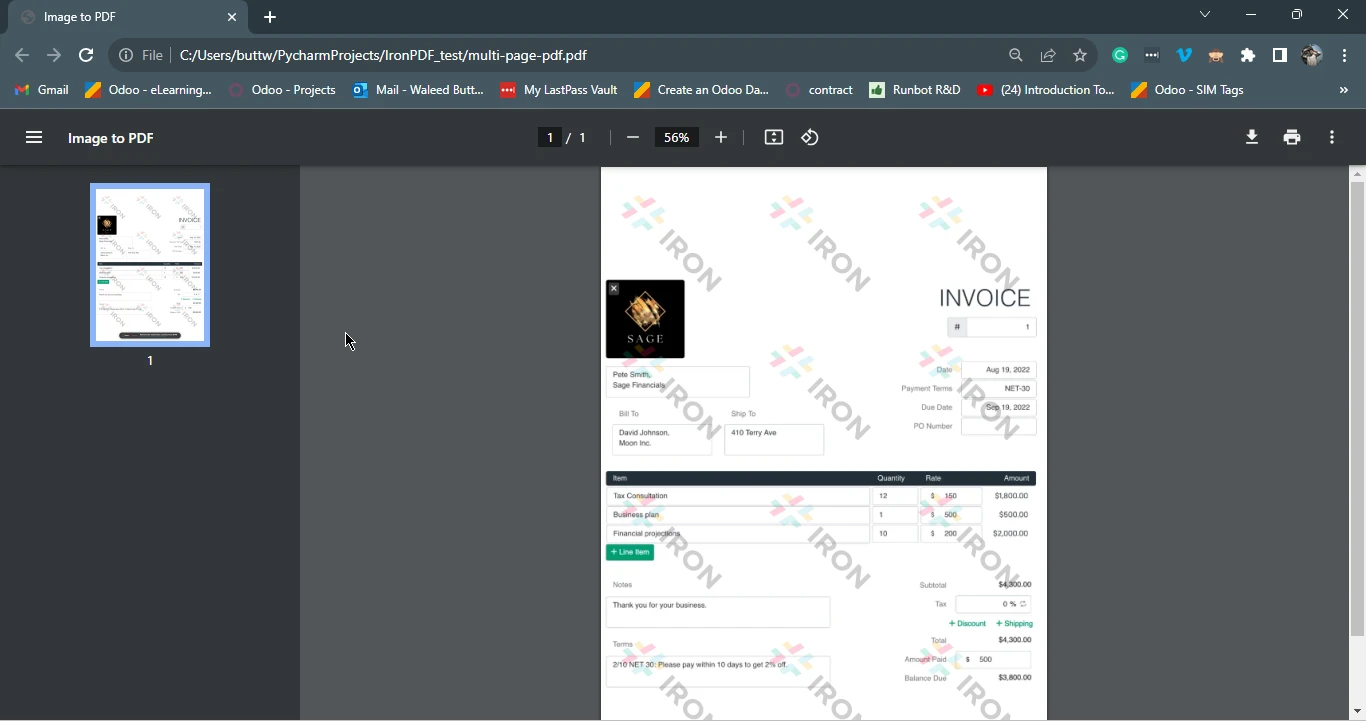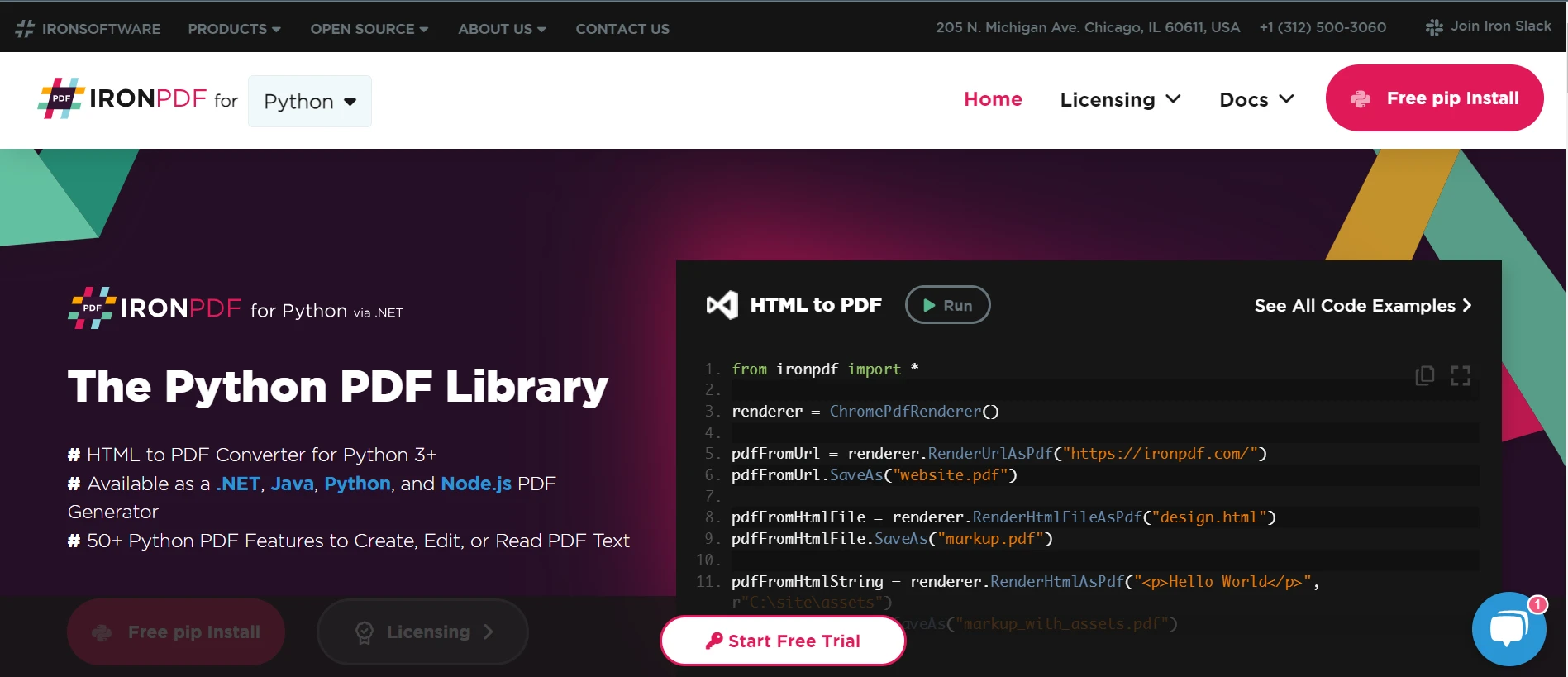How to Convert Image to PDF in Python
This article will explore the world of image-to-PDF conversion in Python, providing you with valuable insights and practical code examples to help you master this invaluable skill. So, let's embark on this journey. The Python file and library will be used in this article is IronPDF for Python.
How to Convert Images to PDF in Python
- Install the Python library for converting images to PDF files.
- Utilize the
ImageToPdfConvertermethod to convert an image to a PDF file. - Save the newly generated PDF documents using the
SaveAsmethod. - Convert multiple images to a single PDF file object.
- Run the project to see the output file.
1. What Is IronPDF?
IronPDF for Python is a versatile library that enables developers to easily generate, manipulate, and work with PDF documents in Python applications. It provides a comprehensive set of tools for creating PDFs from scratch, converting HTML and images into PDFs, and performing various operations on existing PDFs, such as merging, splitting, and adding interactive elements like forms and annotations. With its user-friendly API, IronPDF simplifies PDF generation and manipulation tasks, making it a valuable tool for developers looking to integrate PDF functionality into their Python projects, whether for generating reports, invoices, or interactive documents.
2. Creating a New PyCharm Project and Installing IronPDF
To create a new PyCharm project and install IronPDF, you'll need to follow these steps:
- Install PyCharm: If you haven't already, download and install PyCharm from the JetBrains website (https://www.jetbrains.com/pycharm/). Make sure you have Python installed on your system as well.
- Create a New PyCharm Project: Open PyCharm and follow these steps to create a new project:
- Click on "File" in the top-left corner.
- Select "New Project..."
- Choose the location where you want to create your project and give it a name.
- Select the Python interpreter you want to use for your project (you may need to create a virtual environment if you haven't already).
Install IronPDF: To install the IronPDF library, you can use the Python package manager pip. Open the terminal within PyCharm and run the following command:
pip install ironpdfpip install ironpdfSHELLThis command will download and install the IronPDF library and its dependencies.
3. Convert Images to PDF Files
Once the new PyCharm project folder is created and IronPDF is installed, let's convert an image to a PDF using IronPDF for Python. In the code snippet below, you will see how you can convert an image to a PDF file.
from ironpdf import ImageToPdfConverter
# Convert a single image to PDF
pdf = ImageToPdfConverter.ImageToPdf("win to pay.png")
# Save the converted PDF to a file
pdf.SaveAs("image-to-pdf.pdf")from ironpdf import ImageToPdfConverter
# Convert a single image to PDF
pdf = ImageToPdfConverter.ImageToPdf("win to pay.png")
# Save the converted PDF to a file
pdf.SaveAs("image-to-pdf.pdf")This code snippet uses the IronPDF library to convert an image file named "win to pay.png" into a PDF document. It first creates an ImageToPdfConverter object, passing the path to the image file as a parameter. Then, it saves the converted PDF with the filename "image-to-pdf.pdf" using the SaveAs method. Essentially, it takes an image and transforms it into a PDF file, which can be useful for various document management and sharing purposes.
3.1. Output PDF File
 An invoice output as a PDF
An invoice output as a PDF
4. Convert Multiple Images to a PDF File
Using IronPDF for Python, you can convert and merge all the images in a folder into a single PDF file with just a few lines of code.
The below Python script will show how to composite multiple images into a single PDF file.
from ironpdf import ImageToPdfConverter
import os
# List of image files in the directory "assets" with .jpg or .jpeg extensions
image_files = [os.path.join("assets", f) for f in os.listdir("assets") if f.lower().endswith(('.jpg', '.jpeg'))]
# Convert list of images into PDF
pdf = ImageToPdfConverter.ImageToPdf(image_files)
# Save the resulting composite PDF
pdf.SaveAs("composite.pdf")from ironpdf import ImageToPdfConverter
import os
# List of image files in the directory "assets" with .jpg or .jpeg extensions
image_files = [os.path.join("assets", f) for f in os.listdir("assets") if f.lower().endswith(('.jpg', '.jpeg'))]
# Convert list of images into PDF
pdf = ImageToPdfConverter.ImageToPdf(image_files)
# Save the resulting composite PDF
pdf.SaveAs("composite.pdf")This code utilizes the IronPDF library to convert a list of image files with the extensions '.jpg' or '.jpeg' from a specified directory ("assets") into a single composite PDF document. Here's a step-by-step explanation:
- It starts by importing the necessary modules from the IronPDF library.
- It uses a list comprehension to generate a list of image file paths from the "assets" directory that meet the criteria of having a '.jpg' or '.jpeg' file extension. This list is stored in the
image_filesvariable. - An
ImageToPdfobject is created from theimage_fileslist, converting all specified images into a single PDF document. - Finally, the composite PDF is saved as "composite.pdf" using the
SaveAsmethod.
In summary, this code scans a directory for image files with specific extensions, compiles them into a single PDF document, and saves the resulting PDF as "composite.pdf".
4.1. Output Image
 A PDF of photos, each taking up one page
A PDF of photos, each taking up one page
5. Conclusion
This article explored the world of image-to-PDF conversion in Python, providing you with practical insights and easy-to-follow examples to help you master this essential skill. Through the example of the use of IronPDF for Python, it demonstrated how you can effortlessly convert individual images into PDF documents and even merge multiple images into a single, cohesive PDF file.
With IronPDF's user-friendly API, Python developers can streamline PDF generation, conversion, and manipulation tasks, making it a valuable resource for projects involving reports, invoices, interactive documents, and more. By following the steps outlined in this article, you can harness the power of Python and elevate your document management capabilities, all while simplifying your workflow and improving efficiency.
If you are wondering how to convert PDF files to images, check out this tutorial. Also, the source code for the example Image to PDF can be found as an example on the IronPDF website.
Frequently Asked Questions
How do I convert an image to a PDF in Python?
You can convert an image to a PDF in Python using IronPDF by utilizing the ImageToPdfConverter method. Simply create a converter object with your image file path and use the SaveAs method to generate the PDF.
Is it possible to compile multiple images into one PDF file?
Yes, IronPDF allows you to compile multiple images into a single PDF. You can pass a list of image paths to the ImageToPdfConverter and then save the consolidated PDF using the SaveAs method.
How can I install IronPDF in my Python project?
To install IronPDF in your Python project, open your terminal and run the command pip install ironpdf. This will add IronPDF to your project's dependencies.
What are some common use cases for converting images to PDF using IronPDF?
Common use cases include generating reports, creating image-based invoices, and archiving images as PDF documents for easier sharing and printing.
What troubleshooting steps should I take if my image to PDF conversion fails?
Ensure that the image file paths are correct and that the images are accessible. Verify that IronPDF is installed correctly and that your code is using the ImageToPdfConverter and SaveAs methods properly.
Can IronPDF be used to convert PDFs back to images?
Yes, IronPDF can also convert PDFs back to images, allowing you to extract and manipulate visual data from PDF files for various applications.























